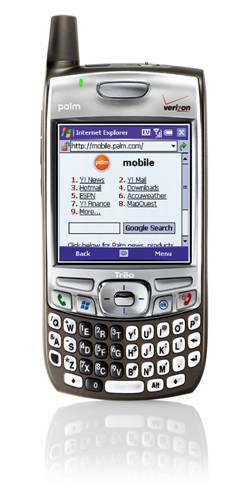 Summary of Hardware
Summary of Hardware
The Treo 700w is nearly unchanged on the outside from earlier Treos. It is a dark-silver grey color making it much more professional looking than the Treo 650.
Inside, the Treo 700w includes an upgraded version of the Intel processor found in the Treo 650, 128 MB (60 MB user accessible) of memory, and a new 3G EVDO radio. This new radio allows for DSL-like speeds on Verizon�s network. It is arguably, the most significant new feature to the Treo line.
The screen, at 240x240 on the Treo 700w, is a lower resolution than the 320x320 on Treo 650, but is a specification required by Windows Mobile.
The keyboard is nearly identical to previously successful Treo keyboards, and one handed five-way navigation support is found in many, but not all of the Treo�s Windows Mobile applications, making one handed use slightly more complicated than on previous Treos.
Asthetics
The Treo 700w is remarkably similar in shape, size, and weight to the Treo 650. At 4.4x2.3x0.9 inches, it is identical in height, width, and depth of existing Treos and only slightly lighter (6oz instead of 6.3oz). From the outside, the device has changed only aesthetically. The toyish-looking blue-purple case on my Sprint Treo 650 was replaced with a professional looking dark silver grey color. The rounded back and corners of the Treo 650 have been made more angular on the Treo 700w.
The circular egg shaped key and five-way navigator have been made square. The screen is framed by flashy silver paint, but it is less noticeable than on the Treo 650. The back speaker grill is now a rectangle instead of an oval. The earpiece hump is much less pronounced. I like these changes because to me, they make the Treo 700w feel more professional, more modern, than the Treo 650.
Inside
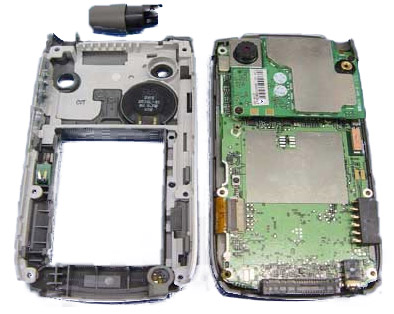 Inside, the Treo 700w is as similar to the Treo 650 as the outside is. The most notable difference is the Treo 700w�s new 3G CDMA radio. Using a dual band digital radio (800/1900Mhz), this radio can do both 1xRTT data (like the current Treo 650), and in most major metropolitan areas EVDO data.
Inside, the Treo 700w is as similar to the Treo 650 as the outside is. The most notable difference is the Treo 700w�s new 3G CDMA radio. Using a dual band digital radio (800/1900Mhz), this radio can do both 1xRTT data (like the current Treo 650), and in most major metropolitan areas EVDO data.
EVDO, branded by Verizon as BroadbandAccess, and by Sprint as PowerVision, has max speeds of 2.0 Mbps. In normal use, speeds range from 400-700 kbps; just a little slower than a DSL connection. If there is any technology in the Treo 700w that changes how you can use the Treo, it is EVDO connectivity.
The Treo 700w uses an Intel PXA272 312 Mhz processor; a slightly newer, smaller version of the PXA270 312 Mhz processor in the Treo 650. The Treo ships with a 128 MB of memory, but only 60 MB are available for user storage. The camera is a healthy 1.3 mega pixels. The microphone is on the bottom, an SD card is at top, and a speakerphone on back. The 1800 mAh battery is identical to the battery in the Treo 650, and like the Treo 650 is removable. Higher capacity batteries are available from third parties.
Screen
The 240x240 TFT 16bit color LCD screen on the Treo 700w is bright and easy to read, like the screen on its predecessor. However, in comparison to the Treo 650�s 320x320 screen, it has almost half as many pixels.
Text is noticeably rougher, but still easily readable on the Treo 700w, and images displayed on the screen are not as sharp. Both screens are approximately the same brightness, but the Treo 700w has a slightly whiter backlight.
Keyboard
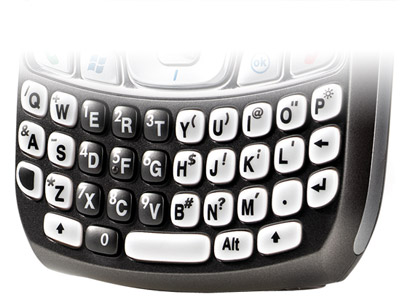 The keyboard on the Treo 700w is slightly more curved into a crescent shape than the keyboard on the Treo 650, but like other features, is otherwise very similar to the Treo 650. The shape of the keys have changed from egg to square, while the key backlight is much whiter. These changes were done strictly from an industrial design perspective.
The keyboard on the Treo 700w is slightly more curved into a crescent shape than the keyboard on the Treo 650, but like other features, is otherwise very similar to the Treo 650. The shape of the keys have changed from egg to square, while the key backlight is much whiter. These changes were done strictly from an industrial design perspective.
Like on the Treo 650, the 5 key is marked by a small nub. The activation energy of the keys seems greater than the Treo 650, and thus typing is just slightly harder; this may simply be an artifact of comparing a worn-in Treo to a new one. It takes time to get used to typing on any thumbboard, and everyone has their favorite style, shape, and spacing; it is of my opinion that the Treo line has a competitive keyboard, useable for emailing, word processing, or just plain web surfing.
The only notable difference in the keyboard is not in the hardware of the keys, but in the way that the alt key works. On all Treos prior, to enter symbols or accented characters, one would type a related character, and press Alt. On the Treo 700w, this process has been reversed; you first type alt to get a list of all characters and symbols, and than a key to narrow the list down. So to get an �, you would press Alt and than a.
At first I disliked this change, (primarily because it took me a week to discover how to narrow down the list!) but after thinking about it, by having the user press alt first it actually makes the alt key more like shift or option, adding consistency to the Treo interface.
The Treo 700w has a great text auto complete feature, that unobtrusively suggests in a dropdown box completions to the word that you are typing. While I did not find it useful for short words, many longer words were easily identified by the auto complete and saved me much typing. The keyboard is backlit like on earlier Treos with a nice bright white color, but sadly, the keyboard backlight is not matched up to the screen backlight and only has one setting � super bright.
Action keys/Five-way
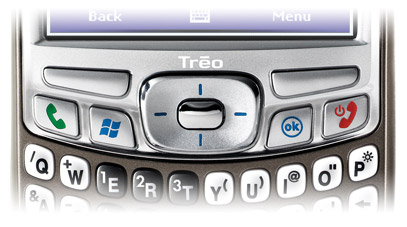 The Treo 700w has the same positioning of action buttons as the Treo 650: a rocker and action button on the left hand side, 4 main keys, a five-way, and two keys above the 4 main keys. The main difference is that there is no room for application specific keys, an �ok� button, and the windows menu key have replaced the messaging and calendar keys. These changes were required to make five-way work well with Windows Mobile. In what some may see as an improvement, and others as a usability disaster, the two upper keys are no longer static for home/menu, but are now soft keys defined by the application running.
The Treo 700w has the same positioning of action buttons as the Treo 650: a rocker and action button on the left hand side, 4 main keys, a five-way, and two keys above the 4 main keys. The main difference is that there is no room for application specific keys, an �ok� button, and the windows menu key have replaced the messaging and calendar keys. These changes were required to make five-way work well with Windows Mobile. In what some may see as an improvement, and others as a usability disaster, the two upper keys are no longer static for home/menu, but are now soft keys defined by the application running.
In programs where Palm had their hand in, five-way (the ability to use the Treo without stylus) support is excellent. The Today screen, contacts, phone app, and messaging are on par with the Treo 650.
However, many of the other crucial programs have poorly implemented five-way support, such as Internet Explorer or Windows Messenger. Unlike on the Treo 650, there is no system-wide five-way indicator. Palm added much of the five-way support to Windows Mobile Pocket PC; five-way support is much easier to find in the stripped down touch screen-less, Windows Mobile Smartphone edition. In the future, there needs to be better five-way support in Windows Mobile Pocket PC, to match the ease of use of the Treo 650.
Keyguard on the Treo 700w is identical in function to that of earlier Treos � press center to unlock. A nice feature that Palm added is the display of the current time in the keyguard window.
Windows Mobile and Phone >>
Copyright 1999-2016 TreoCentral. All rights reserved :
Terms of Use : Privacy Policy
TREO and TreoCentral are trademarks or registered trademarks of palm, Inc. in the United States and other countries;
the TreoCentral mark and domain name are used under license from palm, Inc.
The views expressed on this website are solely those of the proprietor, or
contributors to the site, and do not necessarily reflect the views of palm, Inc.
Read Merciful by Casey Adolfsson
 Summary of Hardware
Summary of Hardware
 Inside, the Treo 700w is as similar to the Treo 650 as the outside is. The most notable difference is the Treo 700w�s new 3G CDMA radio. Using a dual band digital radio (800/1900Mhz), this radio can do both 1xRTT data (like the current Treo 650), and in most major metropolitan areas EVDO data.
Inside, the Treo 700w is as similar to the Treo 650 as the outside is. The most notable difference is the Treo 700w�s new 3G CDMA radio. Using a dual band digital radio (800/1900Mhz), this radio can do both 1xRTT data (like the current Treo 650), and in most major metropolitan areas EVDO data.
 The keyboard on the Treo 700w is slightly more curved into a crescent shape than the keyboard on the Treo 650, but like other features, is otherwise very similar to the Treo 650. The shape of the keys have changed from egg to square, while the key backlight is much whiter. These changes were done strictly from an industrial design perspective.
The keyboard on the Treo 700w is slightly more curved into a crescent shape than the keyboard on the Treo 650, but like other features, is otherwise very similar to the Treo 650. The shape of the keys have changed from egg to square, while the key backlight is much whiter. These changes were done strictly from an industrial design perspective.
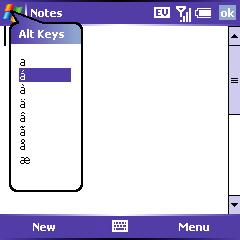
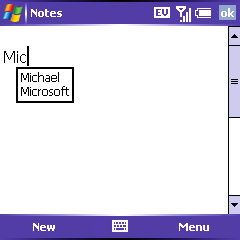
 The Treo 700w has the same positioning of action buttons as the Treo 650: a rocker and action button on the left hand side, 4 main keys, a five-way, and two keys above the 4 main keys. The main difference is that there is no room for application specific keys, an �ok� button, and the windows menu key have replaced the messaging and calendar keys. These changes were required to make five-way work well with Windows Mobile. In what some may see as an improvement, and others as a usability disaster, the two upper keys are no longer static for home/menu, but are now soft keys defined by the application running.
The Treo 700w has the same positioning of action buttons as the Treo 650: a rocker and action button on the left hand side, 4 main keys, a five-way, and two keys above the 4 main keys. The main difference is that there is no room for application specific keys, an �ok� button, and the windows menu key have replaced the messaging and calendar keys. These changes were required to make five-way work well with Windows Mobile. In what some may see as an improvement, and others as a usability disaster, the two upper keys are no longer static for home/menu, but are now soft keys defined by the application running.